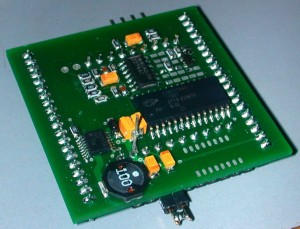
With a few dozen boards to be manufactured and given the limited time frame, I decided to try my luck with an own reflow oven. I went for PCB-Pool‘s approach that combines their PCB and stencil production services with a set of reflow tools for you to do the rest, i.e. baking the boards.
Applying the solder paste thru the stencil went really smooth and fast, while placing the components still took quite some time (but that was to be expected). The reflow itself was done in a few minutes and largely succesful, with just a few shorts across some pins of the one TSSOP chip with its 0.5mm pitch.
Looking forward to do more of this!
With the first two prototypes completed, we had to consider options on how to proceed towards the final product. While we could have strapped off-the-shelf boxes to an ordinary glove, something more elegant was desired, so the call went out for an industrial designer.
Here we found designer duo Christophe Vaillant and Ruth Weber, who were given the task of designing a glove with compartments to hold all the electronics, as well as a carrier for the sensors to be fixed to the fingers. Here’s a pic of an intermediate version:

Working with them was inspiring, also because we’re both into “desktop manufacturing”. E.g. for the sensor carriers they built their own deep drawing machine powered by a hoover:

(The pictures are theirs)

Second prototype, now complete with DC-DC converter and OpAmps for GSR and the optical pulse signal. The board matches the size of the Lantronix Matchport.
Most mobile heart rate systems take their measurements from a simplified EKG circuit mounted on a breast belt. As it will be too cumbersome to ask museum visitors to don this, we decided to go for an optical sensor that clips onto a finger.

In there, the pulsing blood flow changes the amount of IR light that is reflected back to the photo transistor. The disadvantage is that this type of measurement is much more sensitive, in particular when the sensor moves against the skin.
Decided to base the sensor system on Cypress’ PSoC architecture to explore the possibilities regarding its configurable analog subsystem. For now I’m using it to control the gain of the second stage GSR amplification.
Regarding wireless transmission we settled on WLAN and chose a Matchport module from Lantronix.
The cables you see in the picture clip onto standard electrodes.

The eMotion project aims to analyse the experience of museum visitors by tracking their position as well as biometric parameters.
My contribution will be a wireless GSR sensor to measure skin resistance and heart rate, while tracking will be accomplished by ubisense UWB tags.
The team includes psychologists, sociologists, researchers in art theory and visitor studies, musicians, artists, programmers, and designers.
30 years of custom technology for musicians and artists






